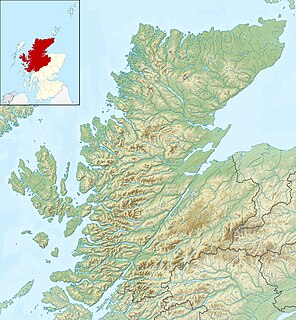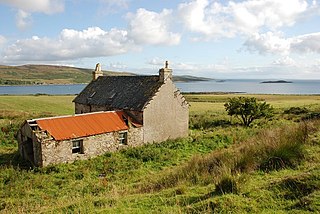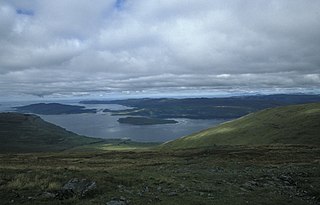
Soay is an island just off the coast of Skye, in the Inner Hebrides of Scotland.

Ulva is an island in the Inner Hebrides of Scotland, off the west coast of Mull. It is separated from Mull by a narrow strait, and connected to the neighbouring island of Gometra by a bridge. Much of the island is formed from Cenozoic basalt rocks, which are formed into columns in places.

Scarba is an island, in Argyll and Bute, Scotland, just north of the much larger island of Jura. The island was owned by Richard Hill, 7th Baron Sandys, and has not been permanently inhabited since the 1960s. It is now covered in heather and used for grazing animals. Kilmory Lodge is used seasonally as a shooting lodge, the island having a flourishing herd of red deer.

The Treshnish Isles is an archipelago of small islands and skerries, lying west of the Isle of Mull, in Scotland. They are part of the Inner Hebrides. Trips to the Treshnish Isles operate from Ulva Ferry, Tobermory and Ardnamurchan in the summer months.

Gometra is an island in the Inner Hebrides of Scotland, lying west of Mull. It lies immediately west of Ulva, to which it is linked by a bridge, and at low tide also by a beach. It is approximately 425 hectares in size. The name is also applied to the island summit, which is a Marilyn.

Inch Kenneth is a small grassy island off the west coast of the Isle of Mull, in Scotland. It is at the entrance of Loch na Keal, to the south of Ulva. It is part of the Loch na Keal National Scenic Area, one of 40 in Scotland. It is within the parish of Kilfinichen and Kilvickeon, in Argyll.

Little Colonsay is an uninhabited island west of the island of the Isle of Mull in Scotland. The geology of the island is columnar basalt, similar to that of neighbouring Staffa. It is part of the Loch Na Keal National Scenic Area, one of 40 in Scotland.

Inchmurrin is an island in Loch Lomond in Scotland. It is the largest fresh water island in the British Isles.

The island of Lunga is the largest of the Treshnish Isles in Argyll and Bute, Scotland, which form part of the Loch Na Keal National Scenic Area.

Cairn na Burgh Mòr is one of the Treshnish Isles in the Inner Hebrides of Scotland.

Oronsay is an uninhabited island in Loch Sunart, Scotland.

Eriska is a flat tidal island at the entrance to Loch Creran on the west coast of Scotland. Privately owned by the Buchanan-Smiths from 1973 until August 2016, Eriska is now owned by Creation Gem, a family-owned business from Hong Kong. The island is run as a hotel with wooded grounds. The island is evidently populated although no record for the total was provided by the census in 2001 or 2011.

The Island of Danna or Danna, is an inhabited tidal island in Argyll and Bute.

Shuna Island or simply Shuna is an island in Loch Linnhe, offshore from Appin. The island is approximately 2 kilometres (1.2 mi) long and 1 kilometre (0.62 mi) wide and extends to some 155 ha in total. The island is characterised by a table topped hill at its southern end. The name Shuna is probably derived from the Norse, for "sea island". The island is separated from Appin by the Sound of Shuna.

Cairn na Burgh Beag is one of the Treshnish Isles in the Inner Hebrides, Scotland.

Inchlonaig is an island in Loch Lomond in Scotland.

Samalan Island is a small island, just off the Isle of Mull at the mouth of Loch na Keal in the Inner Hebrides, Scotland. To its south west is the island of Inchkenneth, and to its north, the island of Ulva.

Loch Tuath is a sea loch in the Inner Hebrides, Scotland that separates the isle of Mull and the island of Ulva. Loch Tuath forms part of the Loch na Keal National Scenic Area, one of the forty national scenic areas in Scotland, which are defined so as to identify areas of exceptional scenery and to ensure its protection from inappropriate development.
Easan Labhar is a series of waterfalls on the island of Mull, Scotland. It lies on the Allt an Easain Labhair near Gruline west of Salen. There are also unnamed waterfalls on the Allt na Linne burn just to the east.

Loch na Keal, meaning Loch of the Kyle, or Narrows, also Loch of the Cliffs, is the principal sea loch on the western, or Atlantic coastline of the island of Mull, in the Inner Hebrides, Argyll and Bute, Scotland. Loch na Keal extends over 20 kilometres (12 mi) inland, almost bisecting Mull, and extending to within 5 km (3 mi) of the eastern shore. The loch gives its name to the Loch na Keal National Scenic Area, one of forty national scenic areas in Scotland.
















